 Introduction to Archaeology
and Palaeoanthropology:
Introduction to Archaeology
and Palaeoanthropology:
 Introduction to Archaeology
and Palaeoanthropology:
Introduction to Archaeology
and Palaeoanthropology:
Humanity's Journeys
Dr. Kathryn Denning
Anth 2140, Sept 2006 - Apr 2007
14 Nov 2006... Welcome!
Plan for class
1) Announcements
2) Hominid evolution: From the australopithecines to Homo erectus -- and Homo floresiensis
Announcements:
Tomorrow in tutorial: Popular representations of our ancestors, including Neanderthals
Reading assignment for next week - continuing with human evolution.
Next week in lecture (21st): All about Neanderthals
Next week in tutorial (22nd): Review and studying skull casts
Quiz 3 will be held in lecture on Tues November 28.
Human evolution overall
Becoming Human (Flash) http://www.becominghuman.org/
(Anatomy... hominid profiles)
Hall of human ancestors http://www.mnh.si.edu/anthro/humanorigins/ha/catalog.htm
RECAP: Historical development of Understanding of Human Evolution
It has long been realized that the key trends in human evolution, i.e. the things that separate us from our ape cousins and ancestors, were...
terrestriality - coming down out of the trees
bipedalism - having to walk on two feet (obligate, not occasional)
encephalization - increase in brain size in relation to body, development of language
civilization - complex technology, moral systems, complex society
But in the earliest days of studying human evolution (up to 1920s), it wasn't known which came first...
- there weren't enough fossils, they weren't well understood, and they weren't securely dated
- Arthur Keith 1895 "Only four individuals to represent the millions and millions of men that must have lived and died in Quaternary times!" (German Neanderthal skull, Pithecanthropus from Java, two Cro-Magnon Belgian skulls) (As opposed to now, when we have MANY)
- so different theories were abundant

This is why the Piltdown forgery worked.... people at the time wanted to believe that big brains came before other human traits, so a big-brained 'fossil' with an ape's jaw fit their preconceptions.
Now, we know that's not what happened... Our brains were still pretty small when we became bipedal.
Your textbook talks about controversies and differences of opinion among palaeoanthropologists. This is because the authors want you to know how this science works:
- we find a fossil
- we reassemble it as best we can
- we analyze it to determine its individual attributes (female or male, age, pathology, etc.), and the fossil's date
- we try to determine its species (what other specimens does it look like... is it similar enough to be placed within an existing species, or is it different enough to warrant a new species name?)
- we carefully compare it to other species and hypothesize about its relationship to other species
- we go and look for more fossils, we try new analytical methods, etc., and we go through the whole process all over again... and we gradually fill in the picture more and more.
All of these stages are difficult, and there is often more than one way to do it. And sometimes we need more data to answer a question definitively.
HOWEVER, the disagreements are usually pretty minor, in the big picture -- e.g. You'll never get a palaeoanthropologist today mixing up an australopithecine with a gorilla or a Neanderthal -- and we definitely know more about human evolution every year.
![]()
By analogy: We already know what the flower looks like. But we're in the process of filling in all the little details.
Although there are occasionally some very interesting and extremely surprising new finds, the general contours of human evolution are now well-drawn. Basic info about locomotion, brain, teeth, and tools (distilled down from many many specimens):

TRENDS in hominid evolution: bipedalism, expansion of brain (cranial capacity), brain complexity, modification of female pelvis, reduction of teeth, face, and jaws, extended period of infant and child dependence, hairlessness...and eventually, apparent increased reliance on meat, emergence of tool use etc.
Cranial capacity: Australos - 380 to 550 cc, vs. early Homo 630-640, vs. Homo sapiens sapiens (us!), usually 1300+ cc N.B. this does vary with body size, and the simple size of the brain alone does not mean greater intelligence within a species. Bigger and more complex brains - linked to stone tool making? around 2.5 mya (Oldowan tool industry),
Pre-australo species
Orrorin tugenensis.... around 6 myr
Sahelanthropus tchadensis – Toro-Menalla region of Djurab Desert in Chad, Central Africa, 6-7 mya
PIC: http://news.nationalgeographic.com/news/2002/07/photogalleries/images/ancestor1.jpg
Australo Species: new ones being discovered all the time! Most hominid fossils found in Great Rift Valley of East Africa, and also in South Africa. (Ethiopian, Tanzania, Kenya, and S. Africa)
Additional recent finds: A. anamensis, A. garhi, etc.
Robust australos: (Paranthropus/Australopithecus boisei, robustus, aethiopicus)
Gracile: A. africanus (Taung child) was an early discovery, A. afarensis (Lucy) was a big find in the 70s (40% of skeleton!)
Australopithecus africanus – 3 to 2.5 mya, found by Raymond Dart in 1925 at Taung, South Africa
Australopithecus afarensis – about 3.2 mya, Maurice Taieb and Donald Johanson, Hadar, Ethiopia [well, actually, a student named Tom Gray], nicknamed “Dinkanesh” or “Lucy”, pretty clearly bipedal... though some arboreal traits.
Laetoli footprints - 3.5 mya, australo, by Mary Leakey. Pic: http://www.mnh.si.edu/anthro/humanorigins/ha/images/laetoli1.jpg
NEW FIND: "Lucy's Baby" -- couldn't have been her baby, but anyway, a juvenile Australopithecus afarensis, also known as the "Dikika baby". Announced this year. 3.3 million years old, about three years of age. Very rare to find juvenile hominid fossils, and this one is quite complete:
http://www7.nationalgeographic.com/ngm/0611/feature6/index.html
http://www.nature.com/nature/focus/hominiddevelopment/index.html#video
Specimen images: http://www.nature.com/nature/journal/v443/n7109/full/nature05047.html
N.b. compare the Dikaka fossil specimen and the popular 'face'
Key features of australopithecines
p 121
- large degree of sexual dimorphism
- cranial capacity c 500 cc
- bell-shaped occipital region
- moderate to large eyebrow ridges
- marked post-orbital constriction
- flaring zygomatic arches
- large face relative to size of brain case
- relatively large and jutting jaw
- no chin
- large/very large premolars and molars, thick enamel, small canines
- bipedal
- bowl-shaped pelvis
- life expectancy 44 years (?)
- opposable thumbs
Characteristics of the genus Homo -- from p 133 -- which distinguish Homo from australopithecines
- a larger cranial capacity
- less postorbital constriction
- more rounded crania
- absence of any crests
- absence of flaring zygomatic arches
- small facial skeleton relative to brain case
- absence of dish-shaped face
- less massive jaw
- smaller molars and premolars
- true parabolic-shaped dental arch
Homo species:
probably developed from either A. africanus or A. afarensis... early Homo lived at the same time as the robust australopithecines
2.5 mya onwards: Homo habilis (Olduvai)
Earliest tools seem 2.5 mya but dispute over who made them (A? H?) -- Oldowan tradition, chopper tools and flakes, pretty basic but very useful for cutting plants and also meat (n.b. we only have stone tools -- and what else might they have used?)
1.8 to 1.5 mya: Homo erectus emerges - significant because these are the first hominids which left Africa, in Europe and Asia
(some have reclassified the African ones as H. ergaster, and the European ones as H. heidelbergensis).
Specimen photos: http://www.mnh.si.edu/anthro/humanorigins/ha/a_tree.html
Early-discovered specimens: 'Java Man', 'Peking Man'. Later discoveries include 'Turkana Boy' from Nariokotome. Bigger brain, different brain proportions, and larger overall body size (like us). Prominent, projecting brows. Very dense thigh bones. Developed Acheulean tool tradition from 1.5 mya. Clear evidence of big game consumption (hunting? scavenging?) Potential use of fire 1.4 mya, definite use and control of fire for cooking 500 000 BP in China. Also apparent use of basic structures. Language? Could be. Looks like their brains were up to it, at a basic level.
Archaic Homo sapiens
Considerable continuity between H. erectus and archaic H. sapiens in some place....hard to draw the line. (still, decreasing jaw, face, back teeth, cranial capacity)
Characteristics of H. erectus ( p 142)
- smaller face and smaller teeth than australopithecines
- sagittal keel
- larger cranial capacity.... around 1000 cc
- skull widest at the base when viewed from the back
- smaller and less flaring zygomatic arch, not extended beyond the ear
- flatter face, with less prognathism (jaw protuberance)
- alveolar prognathism (mouth area only projects forward)
- less-sloping forehead
- pronounced occipital torus
- projecting nose
- large eye orbits
- mandibular torus
- thick long-bone shafts
- larger body size relative to weight
- life expectancy 50 years?
- modern proportions of arms and legs
Special notes about interpreting the fossil and archaeological record
We have to be careful about over-interpreting.... we need to be very aware of the limitations of our data.
e.g. when trying to understand social behaviour... we must be careful not to simply project present or recent human behaviour back into the past, or to use primate examples very literally.
e.g. we know that early hominids made stone tools. But there may have also been wooden tools that didn't survive. (especially bamboo in Asia)
e.g. we know that some early hominids ate meat, because we've found animal skeletons that clearly have butchering marks on the bones, from stone tools. BUT we don't know for sure whether they killed or scavenged. And we don't always know directly what else they ate, because, for example, fruits don't leave behind skeletons. We can make inferences based on tooth wear, however. We can also make inferences based on the technology (e.g. you can't use an Acheulian handaxe as a throwing spear... )
And we are starting to be able to analyze fossils in new ways... for example, a paper published last week showed that carbon isotope signatures in teeth (C4 vs. C3) can tell us whether our ancestors just ate fruit/seeds (C3), or whether they also ate animals who ate grass (C4). (Result: apparently Paranthropus robustus had seasonal changes in diet.... included both fruit/seeds, and animals who ate grass.)

We are presently alone... the last surviving hominid.... but this has not always been the case.
We, Homo sapiens sapiens, coexisted with:
Gigantopithecus (well, a hominoid like other apes, but still a neat case) http://www.eurekalert.org/pub_releases/2005-11/mu-gal111005.php
Neandertals (Homo sapiens neanderthalensis, or Homo neanderthalensis)
The Flores hominids... Homo floresiensis, or unhealthy Homo sapiens?
Experts are still attempting to decide. The following supposes that this is indeed a new species.
Homo floresiensis:

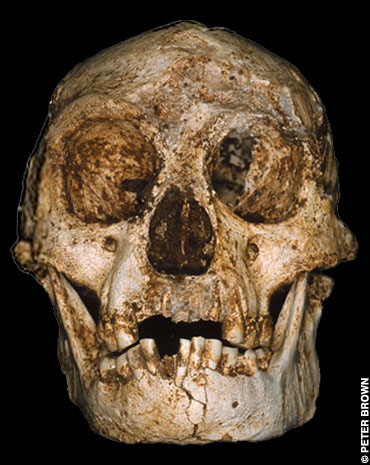
Remains of seven individuals found -- some very fragmentary. Best specimen is above and left: 3 feet/ 1m tall, female, around 30 years old, 18 000 BP. Brain: the size of a chimp's.
Found in eastern Indonesia on the island of Flores, at a cave site called Liang Bua
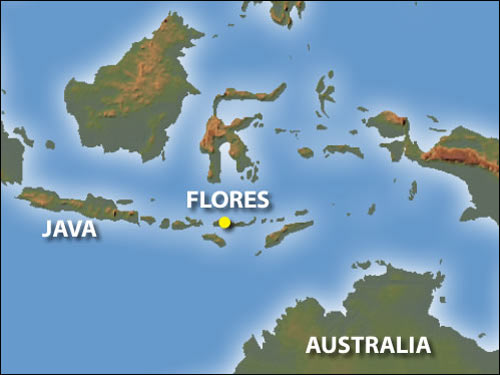
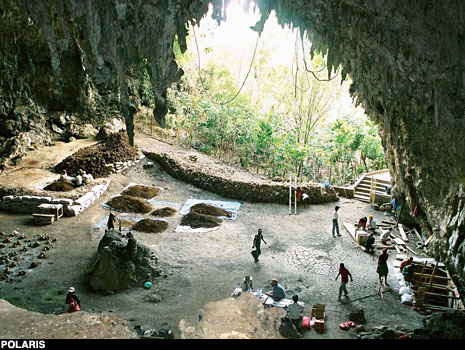
Size compared to modern H. sapiens - absolutely tiny
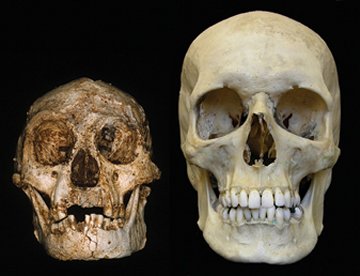

So what is it???
First, what it's not:
It's not "Mini-Me" or a dwarfed Homo sapiens or a known "pygmy". If it was simply a very small H.s., it would have all the same skeletal features ... and it doesn't. It's much smaller than the smallest known normal H.s. And it's not small just because of a known pathology: e.g. the actor below has achondroplasia - premature fusion of long bones, restricting height.... which would be clearly visible skeletally.
And it's not a Hobbit.


H. floresiensis... on the right, compared to H.s.s. and to H. erectus


H. erectus comparisons
Below: Nariokotome boy, Turkana, Africa, H. erectus ... 1.5 mya. Right: "Peking Man", China, H. erectus, 500 000 bp

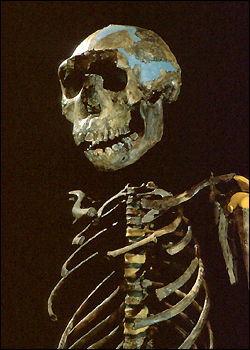
Creatures Homo floresiensis shared their world with:


Komodo Dragons, pygmy Stegodon (elephant, not dinosaur Stegadon), and the Flores Giant Rat http://www.press.jhu.edu/books/walkers_mammals_of_the_world/rodentia/rodentia.muridae.papagomys.html
Major implications
a) Extreme physical adaptation in Homo
Island Dwarfism: e.g. Pygmy Mammoth http://www.nps.gov/chis/pygmy.htm
b) Completely surprising very late survival of H. erectus descendants... coexistence with Homo sapiens sapiens.... so not only did we coexist with Neandertals, but also with H. erectus descendants.... profound biologically and philosophically!
"For most of its 160 000 year history, H. sapiens seems to have shared the planet with other bipedal and cultural beings -- our global dominance may be far more recent than we thought." (M. Lahr and R. Foley, Human evolution writ small, Nature 27 Oct 2004 online http://www.nature.com/news/2004/041025/full/4311043a.html)
c) Revision of the family tree...
d) Further research: Search of other islands for similar specimens... and a reconsideration of ethnographic evidence/folklore...


Above, From Nature: Figure 1. Homo floresiensis in the context of the evolution and dispersal of the genus Homo. The new species as part of the Asian dispersals of the descendants of H. ergaster and H. erectus, with an outline of the descent of other Homo species provided for context.